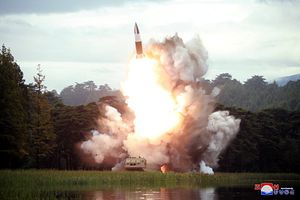On Friday, North Korea conducted the second known tests of a new type of short-range ballistic missile, its state media confirmed. Two missiles were launched along the country’s east coast, reportedly striking a target island. The Korean Central News Agency reported and released images of Friday’s test, confirming that the missile system tested was identical to one tested for the first time earlier this year near the city of Hamhung.
Friday’s test took place from Tongchon, in North Korea’s Kangwon province, a site closer to the inter-Korean demilitarized zone than any used so far this year. According to KCNA, the launches were overseen and guided by Kim Jong Un, the North Korean leader. “Juche shells were fired in the presence of the Supreme Leader,” offering a description of the unnamed missile system.
Friday’s test demonstrated new flight characteristics pertaining to the new weapons system, which is the second kind of new, short-range solid-fuel ballistic missile demonstrated by North Korea this year. The inaugural August 10 flight-test of this missile saw it fly to a range of 400 km at an apogee of 48 km, much closer to the performance of the KN23—the other solid-fuel missile system inaugurated this year.
The latest test, however, exhibited a shorter, depressed trajectory, flying to just 230 km with an apogee of 30 km. Depressed trajectories can reduce the total flight time of a ballistic missile, offering adversary missile defense systems less time to process incoming targets and launch interceptors.
Along with the KN23—another short-range, solid-fueled ballistic missile—and this new system, North Korea also inaugurated a new type of multiple launch rocket system (MLRS) that demonstrated similar flight characteristics. Each of these three weapons tested by North Korea this year appear designed to offer precision and a challenge South Korean and U.S. missile defense systems deployed south of DMZ.
Before Friday’s launches, Kim Jong Un had granted promotions in military rank to 103 scientists involved in efforts to develop these new missile systems.
“Our reliable scientists in the field of national defense science research, who are firmly equipped with the WPK’s revolutionary idea, performed feats to be specially recorded by developing and completing new powerful weapon systems one after another which are of key importance in defending the Party, the revolution, the country and the people and guaranteeing the victorious advance of the revolutionary cause of Juche with matchless military strength,” an article on the decision in state newspaper Rodong Sinmun noted, paraphrasing remarks made by Kim.
The latest launch was the sixth to have taken place since July 25. The ongoing flurry of North Korean missile testing began before the start of the scheduled U.S.-South Korea late-summer computerized command post military exercises and is likely to continue until their conclusion later this month.

































